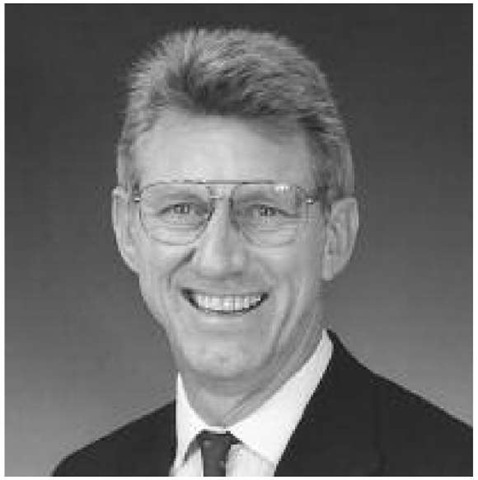(1932- ) Dutch Sedimentologist
Unstable accumulations of sediments at the shelf edge and especially in submarine canyons can slide down the continental slope in essentially an underwater avalanche. This flow of unconsoli-dated debris is called a turbidity current or tur-bidite and it involves no movement of water, just material (sediments). During the Grand Banks Earthquake of 1929, such a turbidite was determined to have sped down the slope at 30 miles per hour as documented by sequential breaking of underwater telephone and telegraph cables. When these turbidites come to rest, they form a very characteristic deposit known as a Bouma sequence, named after its discoverer, sedimentolo-gist Arnold Bouma.
Arnold Bouma is undoubtedly the world’s foremost expert on turbidite deposits and the submarine fans that they commonly form. He produced two volumes, Turbidites and Submarine Fans and Related Turbidite Systems, among many other papers that summarize this work. The Bouma sequence divides turbidite deposits into AD intervals, based upon grain size and sedimentary structures, and as a reflection of proximity to channels in submarine fans. Full sequences only occur in or near channels, whereas distal areas of a fan contain only partial sequences of finer grained material. The dominant types and sequences of sediments can then subdivide the fan. Bouma documented these deposits and the processes that produce them, both in modern settings using sediment cores taken from research vessels, as well as in ancient deposits on land all over the world. Every sedimentology class at every college in the world studies the groundbreaking work of Arnold Bouma. Oil companies also took an interest in his work because these deposits can contain petroleum reserves. Bouma spent many years applying his research to petroleum exploration. He even applied his work to environmental issues like coastal protection and dredging.
Arnold Bouma was born on September 5, 1932, in Groningen, Netherlands. He attended R.H.B.S. (high school and junior college) in Groningen, Netherlands, from 1944 to 1951. He attended the State University at Groningen from 1951 to 1956 and earned a bachelor of science degree in general geology. He earned a master of science degree in geology, sedimentology, and paleontology and a doctorate in sedimentary geology from the State University at Utrecht, Netherlands, in 1959 and 1961, respectively. Bouma won a Fulbright Post-doctoral Fellowship to Scripps Institution of Oceanography, La Jolla, California, in 1962-1963. From 1963 to 1966, he was an instructor at the Geological Institute at Utrecht, Netherlands, and a member of the faculty of oceanography at Texas A & M University from 1966 to 1975. From 1975 to 1981, he was a research marine geologist with the U.S. Geological Survey, first in the Pacific-Arctic branch and later in the Atlantic-Gulf of Mexico branch. He held positions of senior scientist, manager, chief scientist, and acting vice president for Gulf
Portrait of Arnold Bouma
Research and Development Company in Har-marville, Pennsylvania, and Houston, Texas, between 1981 and 1985. In 1985, Gulf Oil Company was bought by Chevron USA, Inc. and Bouma became a senior research associate at Chevron Oil Field Research Company (research and development branch) in Houston, Texas, and La Habra, California. He left Chevron in 1988 to become the Charles T. McCord chaired professor of petroleum-related geology at Louisiana State University in Baton Rouge, where he remains today. He also served as director of the Basin Research Institute and head of the School of Geosciences at Louisiana State University in 1989-1990 and 1990-1992, respectively. Arnold Bouma married Mechilina Kampers in 1961; they have three children.
Arnold Bouma has been phenomenally productive in his career. He has written or edited 11 books and volumes and authored or coauthored 119 articles in professional journals and volumes. Many honors and awards have been bestowed upon him throughout his career, including being a distinguished lecturer for the American Association of Petroleum Geologists in 1982, Francis P. Shep-ard Award from the Society of Economic Paleontologists and Mineralogists in 1982, Best Paper Award at the American Association of Petroleum Geologists Annual Meeting in 1984, Outstanding Education Award from the Gulf Coast Association of Geological Societies in 1992, and keynote speaker at the International Geological Congress in Rio de Janeiro, Brazil, 2000, and at the GEO-SCIENCE 98 Conference at University of Keele, United Kingdom, in 1998, among many others.
His service to the profession is perhaps even more impressive than his papers and awards. Arnold Bouma was editor in chief for Geo-Marine Letters from 1980 to 2000, editor in chief of Marine Geology from 1963 to 1966 (and he is still on the editorial board), and series book editor for Frontiers in Sedimentary Geology from 1985 to present, among several other editorial positions and president of the Society for Sedimentary Geology (SEPM) from 2000 to 2001. He organized Leg 96 (a deep-ocean expedition) of the Deep Sea Drilling Project in 1980-1985. He organized the first COMFAM (Committee on Submarine Fans Meeting). He has served as a member and chair of international professional and government panels and committees too numerous to list here. He organized and convened multiple international conferences, short courses and field trips both topical (on turbidites) and general. He even helped to produce a BBC-AAPG film, Deep Water Sands, in 1985-1986.

